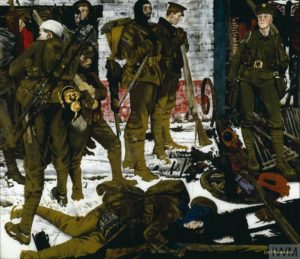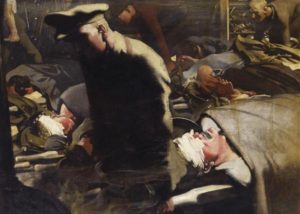Saturday June 15th, 1918
Reveille 4:30. Parade 7 -11:30. Machine gun class. Very hot indeed. Mail up – three letters and five papers. One from wife, one Fred Allen and Abram. Pay Day 25 Drachma. Went to Divisional Concert Hall for the Regiment’s final concert. Place crowded. Got back tired.
The Chocolate Soldier
Seats have been reserved for half the Battalion at the Divisional Concert Hall. Frank was obviously part of this number and apparently has now seen a performance of ‘The Chocolate Soldier‘. He doesn’t comment on it, though the War Diary reckons it was ‘much appreciated by all’.
Preparation for the Western Front
While it hasn’t been formally confirmed, it seems that everyone is aware that the likely destination for the Battalion is to be the Western Front. The drill today and for the next couple of weeks will be firing practice while wearing gas masks. This preparation must be both comforting and rather scary.
Art & Poetry
Frank gets five newspapers and three letters today. Presumably the newspapers will be full of the the German offensives on the Western Front. It must be clear how important reinforcements are in that beleaguered war zone.

One article in The Guardian today is about an exhibition of war pictures. Eric H Kennington had served in the ranks on the Western Front before being invalided out in 1915 and returning in 1917 as an official war artist.
This painting, ‘The Kensingtons at Laventie’, is probably his most famous. It shows Kennington and members of his platoon resting in the village of Laventie after four days in the trenches in bitter weather. Exhausted and pensive, they await orders to ‘Fall in’ for the next part of their journey. The picture is a complex reverse painting on glass, where exterior layers of paint are applied first, giving the oils a particular clarity. Kennington painted this tribute to his comrades after he was invalided out of the army in 1915.^
The second painting was probably the highlight of this new exhibition. It was based on drawings Kennington had made at the 55 Casualty Clearing Station in Tincourt near Peronne during the bombardment that proceeded the 1918 German offensive.*

The Guardian reported, ‘The chief painting, which is connoted in the catalogue by the quotation of Robert Nichol’s fine poem ‘Fulfilment’ shows stretcher-bearers laying down forms of youths with the aniline-red flush of mustard gas on their faces.’¹
The third and fifth verses of Robert Nichol’s poem ‘Fulfilment’ are:
‘And any moment may descend hot death
To shatter limbs! Pulp, tear, blast
Beloved soldiers who love rough, life and breath
Not less for dying faithful to the last.
Was there love once? I have forgotten her.
Was there grief once? Grief yet is mine.
O loved, living, dying, heroic soldier,
All, all my joy, my grief, my love, are thine.’²
As the newspaper summarized, ‘This exhibition distinctly tells us finely something more about the war, and something that must help the home public to realize what it is.’¹
This is the environment for which Frank and the 13th, with their machine gun practices and gas helmets, are being prepared.
13th (Service) Battalion War Diary – 15h June 1918 – La Marraine
Work and fatigues as before except that evening parade was cancelled to enable Battalion to attend 22nd Division Theatre. Battalion allowed 450 seats for men besides officers & sergeants. Performance of ‘The Chocolate Soldier’ much appreciated by all.
References & Further Reading
¹ ‘Mr Kennington’s War Pictures’ on page 6 of The Guardian, June 15th, 1918
^ IWM Art 15661 copyright Imperial War Museums
* IWM Art 4744, copyright Imperial War Museums
² ‘Fulfilment’ by Robert Nichols, published in ‘A Treasury of War Poetry’ (1917) edited by GH Clarke (may be subject to copyright)


